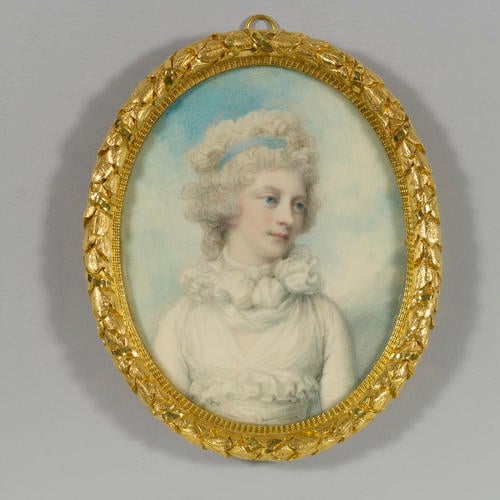Princess Sophia (1777-1848) c.1792
Watercolour on ivory | 7.9 x 6.4 cm (support, canvas/panel/stretcher external) | RCIN 420001
-
In this miniature portrait of Princess Sophia, aged 15, the artist has finished the head only, lightly sketching in the background. Her hair is painted with many small brushstrokes, but her costume is outlined in a few quick ones leaving the ivory base exposed in some places, such as the right sleeve. The artist, Richard Cosway, sometimes flattered his female sitters by elongating the neck and enlarging the pupils of the eyes, as can be seen if this portrait is compared with Sir William Beechey's painting of the Princess dating from 1797 (RCIN 403417). Cosway often made several versions of royal portraits for family members. A version of this miniature was in the collection of Princess Sophia's brother, Adolphus, Duke of Cambridge, and another belonged to her sister, Princess Mary, Duchess of Gloucester.
Princess Sophia was the fifth daughter of George III and Queen Charlotte and the favourite sister of the Prince of Wales and the Duke of Kent. Like her sisters, Sophia led a sheltered early life at Windsor Castle. The King was very attached to his daughters and reluctant to let them marry and leave home. Lord Melbourne later told Queen Victoria that when young, Princess Sophia was very pretty 'though very like a gipsy'. Princess Sophia's name was romantically attached to an equerry, Major-General Thomas Garth (1744–1829). She never married and after Queen Charlotte's death, lived in Kensington Palace, near the Duchess of Kent and the young Princess Victoria. Like the Duchess, she fell under the influence of Sir John Conroy, who took over her finances and this friendship alienated her from Victoria. Following her death in 1848, it became apparent that Conroy had embezzled most of her money.
Richard Cosway (1742-1821) was born in Devon, the son of the headmaster of Blundell's school, Tiverton. The family were prosperous, and owned a woollen business and property. At the age of 12, Richard was sent to London to study drawing under Thomas Hudson at Shipley's drawing school. He entered the Royal Academy Schools in 1769 and exhibited at the Royal Academy between 1770 and 1806. He married Maria Hadfield in 1781, an accomplished artist herself. The couple had one daughter, who died at the age of seven. Richard Cosway's portrait of Maria Fitzherbert attracted the attention of the Prince of Wales who appointed him as his official miniature painter in 1786 and general advisor for the decoration of Carlton House, his residence in London. In 1811, however, Cosway lost the Prince's favour and his eyesight began to fail. He was an eccentric and outlandish in his behaviour and dress, but was an astute collector and acquired a fine collection of old master drawings. His miniatures are painted with a delicacy and fine modelling, and he developed the technique of using transparent pigments which allows the natural luminosity of the ivory to shine through.
Signed and dated on the original backing card in ink: Rdus Cosway. /R.A. / Primarius Pictor / Serenissimi Walliae / Principis / Pinxit / 1792 (and G.P. in another hand).
Catalogue entry adapted from Masterpieces in Little: Portrait Miniatures from the Collection of Her Majesty The Queen (1992) and George III and Queen Charlotte: Patronage, Collecting and Court Taste (2004).Provenance
Probably commissioned by George IV when Prince of Wales; first certainly identifiable in the Royal Collection, 1851
-
Creator(s)
(framemaker) -
Medium and techniques
Watercolour on ivory
Measurements
7.9 x 6.4 cm (support, canvas/panel/stretcher external)
9.2 x 7.6 cm (frame, external)
7.7 x 6.0 cm (sight)
Category
Object type(s)
Other number(s)
Cust 1910 : Cust, L., 1910. Windsor Castle: Portrait Miniatures, London – Cust 1910 III/147RL 1870 11.C.2









